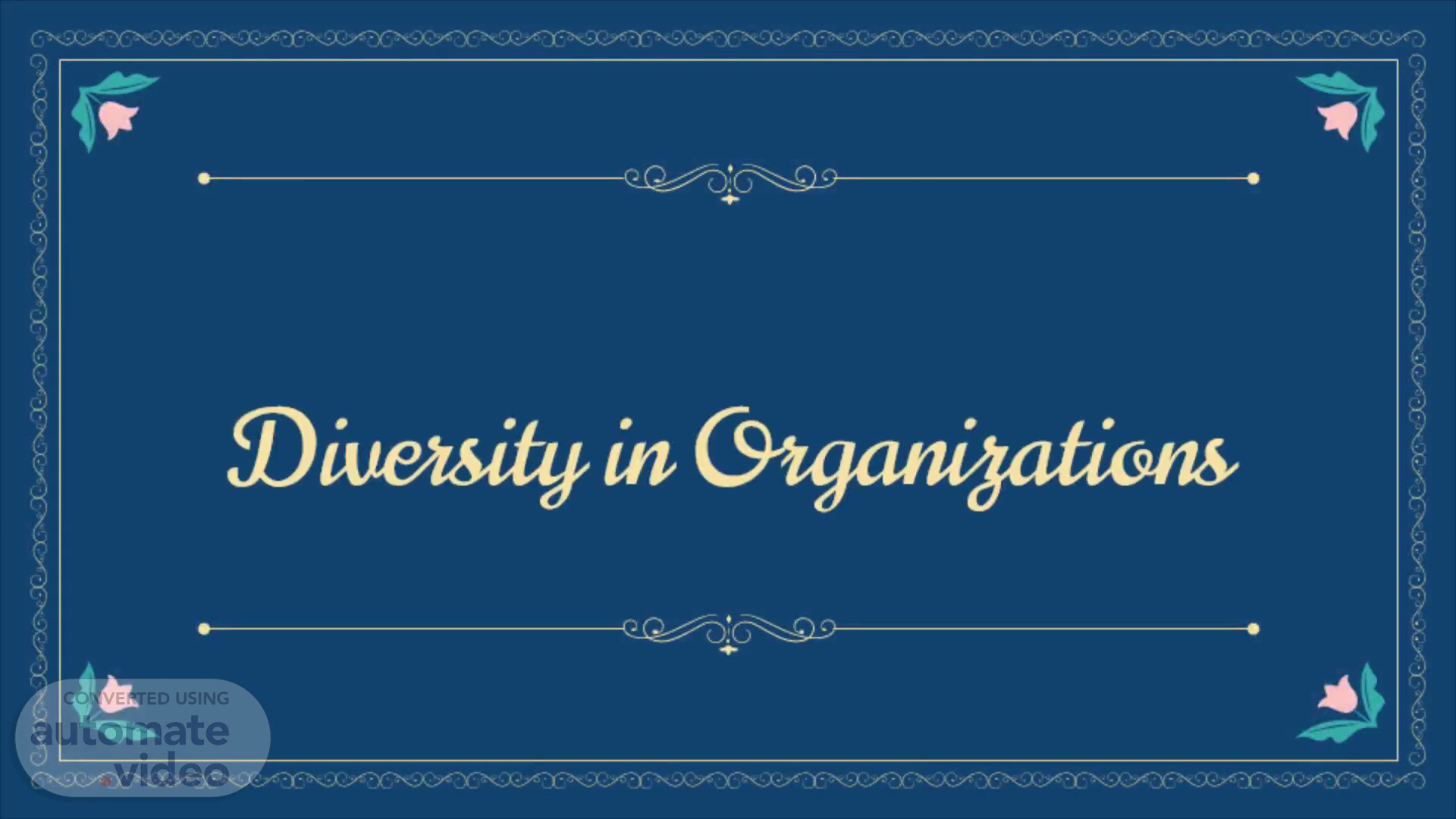
Diversity in Organizations
Scene 1 (0s)
Diversity in Organizations.
Scene 2 (7s)
Presented By:. Group D:. Zakariya Ali. Shevin Glasgow.
Scene 3 (19s)
Diversity. The extent to which members of a group are similar to, or different from, one another..
Scene 4 (30s)
2-1. The 2 major forms of workplace diversity.
Scene 5 (39s)
Levels of Diversity. Surface-level diversity Differences in easily perceived characteristics, such as gender, race, ethnicity, age, or disability, that do not necessarily reflect the ways people think or feel but that may activate certain stereotypes..
Scene 6 (1m 0s)
Surface and Deep-Level Diversity dace-Level Diversity Personality Attitudes physical Deep-Level Diversity Cqpabilities S Values!Behets Hace! Ethnicity.
Scene 7 (1m 9s)
How workplace discrimination undermines organizational effectiveness..
Scene 8 (1m 18s)
Noting of a difference. between things; often we refer to unfair.
Scene 9 (1m 32s)
Stereotyping Judging someone on the basis of our perception of the group to which that person belongs..
Scene 10 (1m 46s)
Type of Discrimination Discriminatory policies or practices Sexual harassment Intimidation Mockery and insults Exclusion Incivility Definition Actions taken by representatives of the organization that deny equal opportunity to perform or unequal rewards for performance. Unwanted sexual advances and other verbal or physical conduct Of a sexual nature that create a hostile or offensive work environment. Overt threats or bullying directed at members of groups of employees. Jokes or negative stereotypes; sometimes the result of jokes taken too far. Exclusion Of certain people from job opportunities, social events, discussions, or informal mentoring; can occur unintentionally. Disrespectful treatment, including behaving in an aggressive manner, interrupting the person. or ignoring his or her opinions. Examples from Organizations Older workers may be targeted for layoffs because they are highly paid and have lucrative benefits. Salespeople at one company went on company-paid visits to strip clubs. brought strippers into the office to celebrate promotions, and fostered pervasive sexual rumors. African-American employees at some companies have found nooses hanging over their work stations. Arab-Americans have been asked at work whether they were carrying bombs or were members of terrorist organizations. Many women in finance Claim they are assigned to marginal job roles or are given light workloads that don't lead to promotion. Female lawyers note that male attorneys frequently cut them off or do not adequately address their comments..
Scene 11 (2m 36s)
2-3. Key biographical characteristics in relation to OB.
Scene 12 (2m 45s)
Biographical Characteristics. Personal characteristics—such as age, gender, race, and length of tenure—that are objective and easily obtained from personnel records. These characteristics are representative of surface-level diversity ..
Scene 13 (2m 59s)
Biographical Characteristics. Age - in the workforce is likely to be an issue of increasing importance during the next decade for many reasons. Sex - few issues initiate more debates, misconceptions, and unsupported opinions than whether women perform as well on jobs as men. Hidden Disabilities – ADHD, insomnia, PTSD.
Scene 14 (3m 27s)
2-4. Differentiating characteristics in relation to OB..
Scene 15 (3m 36s)
Differentiating Characteristics. These characteristics illustrate deep-level differences that provide opportunities for workplace diversity, as long as discrimination can be overcome..
Scene 16 (3m 47s)
Differentiating Characteristics. Tenure – time spent in a job, organization, or field. Religion - employers are prohibited by law from discriminating against employees based on religion in many countries, including Australia, the United Kingdom, and the United States..
Scene 17 (4m 13s)
The relevance of intellectual and physical abilities to OB..
Scene 18 (4m 23s)
An individual’s capacity to perform. the various tasks in a job..
Scene 19 (4m 32s)
Intellectual Ability Perform mental health activities such as thinking, mental reasoning, verbal comprehension, analyzing, and problem-solving. Measures intelligence and involve understanding complex concepts and thinking critically. Plays a vital role in complex jobs with demanding information processing requirements..
Scene 20 (4m 58s)
Relevance to OB. Intellectual Ability Key abilities of employees that will lead to organization success Employees need to have certain abilities to be valuable to the organization It helps in job evaluation A high ability-job fit.
Scene 21 (5m 18s)
Exhibit 2-3 Strength Factors I. Dynamic strength 2. Trunk strength 3. Static strength 4. Explosive strength Flexibility Factors 5. Extent flexibility 6. Dynamic flexibility Other Factors 7. Body coordination 8. Balance 9. Stamina Nine Basic Physical Abilities Ability to exert muscular force repeatedly or continuously over time Ability to exert muscular strength using the trunk (particularly abdominal) muscles Ability to exert force against external objects Ability to expend a maximum of energy in one or a series of explosive acts Ability to move the trunk and back muscles as far as possible Ability to make rapid, repeated flexing movements Ability to coordinate the simultaneous actions of different parts of the body Ability to maintain equilibrium despite forces pulling off balance Ability to continue maximum effort requiring prolonged effort over time.
Scene 22 (6m 13s)
How organizations manage diversity effectively. 2-6.
Scene 23 (6m 21s)
Diversity Management. The process and programs by which managers make everyone more aware of and sensitive to the needs and differences of others..
Scene 24 (6m 33s)
Diversity Management Strategies. Attracting, Selecting, Developing, and Retaining Diverse Employees - targeting recruitment messages to specific demographic groups that are underrepresented in the workforce. Diversity in Groups - groups of individuals with different types of expertise and education are more effective than homogeneous groups..
Scene 25 (6m 57s)
THANK You!.